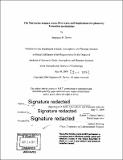| dc.contributor.advisor | Linda T. Elkins-Tanton. | en_US |
| dc.contributor.author | Brown, Stephanie Marie,Ph.D.Massachusetts Institute of Technology. | en_US |
| dc.contributor.other | Massachusetts Institute of Technology. Department of Earth, Atmospheric, and Planetary Sciences. | en_US |
| dc.coverage.spatial | zme---- | en_US |
| dc.date.accessioned | 2018-03-27T14:20:01Z | |
| dc.date.available | 2018-03-27T14:20:01Z | |
| dc.date.copyright | 2009 | en_US |
| dc.date.issued | 2010 | en_US |
| dc.identifier.uri | http://hdl.handle.net/1721.1/114380 | |
| dc.description | Thesis: S.B., Massachusetts Institute of Technology, Department of Earth, Atmospheric, and Planetary Sciences, June 2010. | en_US |
| dc.description | Cataloged from PDF version of thesis. | en_US |
| dc.description | Includes bibliographical references (pages 29-33). | en_US |
| dc.description.abstract | The size of the Mercurian core and the low ferrous iron bearing silicate content of its crust offer constraints on formation models for the planet. Here we consider a bulk composition that allows endogenous formation of the planet's large core, and by processing the mantle through a magma ocean, would produce a low-iron crust. More Earth-like bulk compositions require silicate removal, perhaps by a giant impact, to create the planet's large core fraction. The earliest crusts expected in a giant impact scenario are discussed in comparison to the endogenous model. We find that the endogenous model can produce a large core with either a plagioclase flotation crust or a low-iron magmatic crust. For the giant impact model, in the absence of a plagioclase flotation crust, the impact may be constrained to occur within about 300,000 years of the planet's initial fractionating magma ocean, at which time the giant impact can remove most of the silicate iron oxide budget of the planet before gravitational overturn carries it into the deep planetary interior. Thus a specific bulk composition is required to make Mercury endogenously, but specific timing of events is required to make it exogenously through giant impact. Measurements taken by the MESSENGER mission, when compared to predictions given here, may help resolve Mercury's formation process. | en_US |
| dc.description.statementofresponsibility | by Stephanie M. Brown. | en_US |
| dc.format.extent | 43 pages | en_US |
| dc.language.iso | eng | en_US |
| dc.publisher | Massachusetts Institute of Technology | en_US |
| dc.rights | MIT theses are protected by copyright. They may be viewed, downloaded, or printed from this source but further reproduction or distribution in any format is prohibited without written permission. | en_US |
| dc.rights.uri | http://dspace.mit.edu/handle/1721.1/7582 | en_US |
| dc.subject | Earth, Atmospheric, and Planetary Sciences. | en_US |
| dc.title | The Mercurian magma ocean, first crust, and implications for planetary formation mechanisms | en_US |
| dc.type | Thesis | en_US |
| dc.description.degree | S.B. | en_US |
| dc.contributor.department | Massachusetts Institute of Technology. Department of Earth, Atmospheric, and Planetary Sciences | en_US |
| dc.identifier.oclc | 1028994018 | en_US |
